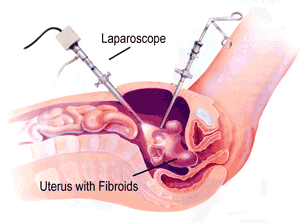Laparoscopic Myomectomy
Fibroids that are attached to the outside of the uterus by a stalk (pedunculated myomas) are the easiest to remove laparoscopically. Many subserous myomas (close to the outer surface) can also be removed through the laparoscope.
What is a laparoscopic myomectomy?

Which fibroids can be removed laparoscopically?
Fibroids that are attached to the outside of the uterus by a stalk (pedunculated myomas) are the easiest to remove laparoscopically. Many subserous myomas (close to the outer surface) can also be removed through the laparoscope.
Fibroids that are deep in the wall of the uterus, or submucous are most difficult to remove laparoscopically. Although there have been successful pregnancies after laparoscopic removal of deep or multiple myomas, the real question is whether or not the uterus can be repaired as well through the laparoscope as can be done through an abdominal myomectomy.
What are the advantages and disadvantages of laparoscopic myomectomy?
The advantage of a laparoscopic myomectomy over an abdominal myomectomy is that several small incisions are used rather than one larger incision. It is important to understand that even a laparoscopic myomectomy is real surgery, and often requires several weeks of recovery. Another major factor in recovery time is motivation; I have found motivation can be just as important in recovery as the type of surgery.
One concern when there are multiple fibroids is of leaving smaller myomas behind. Often it is necessary to feel the uterus to find the smaller myomas; these likely would be left behind during a laparoscopic myomectomy. To summarize, I think laparoscopic myomectomy is best for pedunculated and superficial myomas. When there are deep myomas and a large number of myomas, I think that it is possible to repair the uterus better by doing an abdominal myomectomy.
A bit of editorializing...
One of my colleagues assisting me in a difficult laparoscopic surgery asked me when would I do a laparotomy (make a regular incision.) My answer was that I do the type of surgery that will obtain the best results. If I can obtain just as good results through the laparoscope I will do the procedure that way. But if I feel I can do a better job through a regular incision, then I will recommend that approach. When someone looks back years after surgery, the quality of surgery inside will be far more important than recovering 1 or 2 weeks earlier. Sometimes I will take a look through the laparoscope, and decide which way to approach the myomectomy at that time.
Please also visit Dr. Indman's award winning websites and blog:
Uterine Fibroids Blog - An Expert Speaks Out
(Real Women's Stories, Case Presentations, Review of Latest Information)
Fibroids, Hysteroscopy, Endometrial Ablation, Abnormal Pap Test
(Alternatives in Gynecology)
All About Myomectomy for Removal of Uterine Fibroids Fibroid Medical Center of Northern CaliforniaGynecologic Causes of Pain
